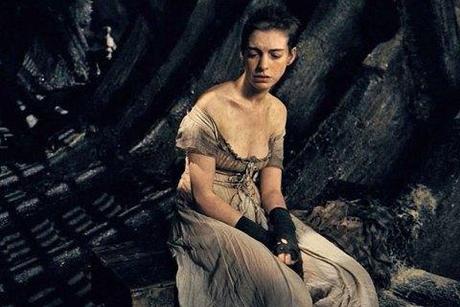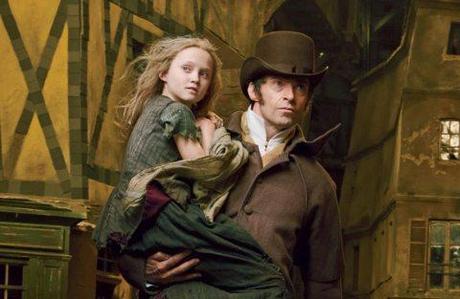
by Steve Habrat
Two years after Tom Hooper’s The King’s Speech took the world by storm and made off with the Best Picture Oscar, the British director returns with a film so immense and extravagant, you won’t be able to believe your eyes. Hooper’s Les Misérables is certainly a worthy follow up to The King’s Speech, but in size and scope, Les Misérables blows it right out of the water. As epic as they come, Les Misérables is a big Hollywood blockbuster (and a shameless one at that), one sure to run away with awards like Best Costume Design, Best Makeup and Best Production Design at the Academy Awards, but just like its predecessor, the film bowls over the viewer with one gigantic tidal wave of emotion after another. Just when you thought you’ve recovered from one heart wrenching moment, Hooper unleashes another one almost instantly. The film, and the stars who inhabit it, belt their hearts out as tears stream down their muddy faces, singing live over having the lyrics dubbed in post production. Each and every one of them will give you chills, especially Anne Hathaway’s teary-eyed “I Dreamed a Dream.” For as high as this film flies, it could still have stood to have at least forty minutes cut from it, mostly because by the final act, we do begin to feel it’s epic runtime of two hours and forty minutes. It appears that Hooper was wildly faithful to the musical and the novel by Victor Hugo, which is both a blessing and a curse.
Beginning in 1815, prisoner Jean Valjean (Played by Hugh Jackman) is released on parole by chilly prison guard Javert (Played by Russell Crowe) after serving a brutal seventeen-year sentence. Valjean is cast out into the world without any food or a home but is soon taken in by the kindly Bishop of Digne (Played by Colm Wilkinson), who offers him a hot meal and a bed. In the night, Valjean steals some of the Bishop’s silver and then flees, only to be quickly caught by local authorities. The Bishop insists that he gave Valjean the silver as a gift and demands that they let him go free. Moved by the Bishop’s kindness, Valjean breaks his parole and sets out to make a better life for himself. Eight years pass and Valjean, who goes by a new name, is now the mayor of Montreuil-sur-Mer and a factory owner. Employed at his factory is Fantine (Played by Anne Hathaway), who is discovered by her co-workers to be an illegitimate mother sending money to her sick daughter, Cosette (Played by Isabelle Allen), and is fired by the foreman. Desperate, Fantine turns to prostitution to make money but one evening, Javert confronts her after she attacks a belligerent customer. Javert tries to haul her off to jail but Valjean quickly stops him after he recognizes her from the factory. Near death, Fantine begs Valjean to find her daughter and to take care of her. Valjean agrees and sets out to find Cosette, but Javert begins to suspect that Valjean is the prisoner who broke parole eight years earlier and he begins hunting him down.
Each and every frame of Les Misérables looks like it cost almost $100 million dollars to project onto the screen. The makeup effects are absolutely astounding, especially the aging of Jackman’s Valjean as the story progresses. Every smudge of dirt and speck of filth so perfectly splattered across each actor’s face. Another standout moment is when Valjean trudges through the sewer with rebellious student Marius (Played by Eddie Redmayne) and human waste covers them from head to toe. It is appropriately nasty to the point where you can practically smell the stench. The costumes are all wildly detailed and eye catching, especially a jacket worn by Valjean with a massive collar. Then there are the special effects, especially the overhead shots of small villages and growing cities that are so fussy, they make you want to tear your hair out. Hooper hurls his camera directly at them to focus in on one specific character standing on the edge of a cliff or riding a horse through the streets. Later in the movie, there are one or two scenes that feel more like indoor sets rather than outdoor locations, which sort of take us out of the moment. I couldn’t help but wish that Hooper would have at least attempted to shoot them outside but I can’t imagine that he would have been able to pull off some of the environment detail that he was going for if he chose to shoot outside.

The other big draw to the big screen adaptation of Les Misérables is the live singing done in front of the camera rather than the music studio. While many critics and audience members have complained that it was a failed experiment (I don’t really understand why they think it was a failed experiment), I personally liked it and found that it adds a layer of realism to the bombastic gloss of this expensive epic. It allowed Hooper to apply long takes of his actors doing the thing that pays them millions of dollars— act. Sure there are a few brief cuts here and there, but Hooper lets the camera sit (and sometimes pace) with all the actors. We get up close and personal views of brokenhearted emotion heating up and then boiling over as the viewer hangs on the frame in a state of awe. While some of the voices are certainly not going to nab a record deal (looking at you, Mr. Crowe), you still have to admire their confidence to let their voices soar. The lack of a true professional makes things all the more realistic and down-to-earth. Some musicals (not all) loose me when the actors sing like trained professionals.
While Les Misérables is beautiful to look at, the film wouldn’t be what it is if it wasn’t for the downright incredible performances at the heart. While I’ve never downright hated Jackman as an actor, I could never really see the big deal about him but with Les Misérables, I am a true believer now. This guy is fantastic as Valjean, the tortured ex-prisoner who had his life turned upside down over stealing a mouthful of bread. While it is Jackman’s show, the one who makes off with the movie is Hathaway as Fantine, a woman forced into a life of hell. I promise that you will practically fall out of your seat when she performs “I Dreamed a Dream” as she battles back tears of embarrassment and defeat. It is a rare scene where the audience member actually wants to leap to their feet and break into applause. Crowe is great as the relentless Javert, who is always hot on Valjean’s heels. I can’t say too much for his vocal performance but the fact that he is really trying is good enough for me. Sacha Baron Cohen and Helena Bonham Carter drop by to add a bit of (grotesque) comedy to the mix as Thénardier and Madame Thénardier, a couple of pick pockets who are taking care of darling little Cosette. Amanda Seyfried is a bit stiff as the adult Cosette, as is Redmayne as her suitor Marius. They get a last act love story and while it is effective, neither of them make us root for them like we should. Samantha Barks is also present as the Thénardier’s daughter Éponine, who secretly loves Marius. Barks wins our empathy with a lovely but painful solo performance in the rain.
While Les Misérables won’t win over every single viewer over, if you’re a fan of the book or the musical by Alain Boublil and Claude-Michel Schonberg, you are going to gush over Hooper’s achievement. I’d also say that if you enjoy musicals like I do, you are probably going to be hooked for a good majority of the movie. If you’re a casual moviegoer, be prepared for the longest two hours and forty minutes of your life. I still felt that the film ran a bit too long and some of the musical numbers could have been trimmed for a tighter and more inviting runtime, but there really isn’t one weak number of the bunch. Another minor complaint I had with the film was the fate of one of the characters, which just seemed downright bizarre and random. Overall, Les Misérables is overblown, funny, thrilling, mildly romantic, raw, repulsive, and most importantly, moving. It may have its flaws but is has everything a film fan could want in a movie and it really is a beautiful work of art to lay your eyes on. A phenomenal achievement for the very talented Mr. Hooper and the musical genre.
Grade: A-
